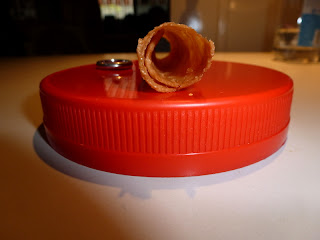Gong Xi Fa Cai, or Kung Hei Fat Choi!
[Mandarin, or Cantonese]
After kicking off Monday morning with a run, we spent the rest of the day visiting Kee-Min's family. The Chinese New Year tradition is to visit the elders of each family at their homes, where you present them with 2 oranges or similar citrus fruits (the words for orange citrus fruits - oranges, mandarin oranges, tangerines - when translated into various Chinese dialects, all sound like good things to wish someone - good fortune, wealth, luck...), and possibly other gifts/sweets. They welcome you, feed you some snacks, and after some socializing, you move along to the next house.
The size of the family, and visiting traditions, determine the length of your visiting day! Both of Kee-Min's parents are the youngest children in their families, so there can be quite a lot of visiting. For various reasons (death, co-living, etc.), the visiting has been streamlined in recent years, and we only made 5 stops yesterday, plus a visit to the Bhuddist temple where some of his relatives' ashes are kept.
Today, we've already done one visit and have 2 more on tap for this afternoon. It's actually been quite fun, and I've gotten to re-meet much of Kee-Min's family. [There were 300 friends & family at our wedding dinner, so I was in 'survival' mode, not 'meet and remember' mode.] I also enjoy the look on the face of someone who hasn't met me before when we come to them in the receiving/shaking hands/welcoming line at a new house. I read the look to mean something like, "Huh? Who are you? Your face is wrong. Should I wish you a Happy New Year? *looks left and right* Uhh..I guess so. OK!" Hehehe...
I love the tradition of visiting and honoring your elders. I love watching families meet. I love walking down the street or through the HDB flats and hearing the chatter, banter, and exclamations of families and friends coming together. I don't understand all of the customs, and I'm a little put-off by the focus on wealth - but how can I argue with a holiday that encourages respect, family, and eating?? Speaking of eating...
Chinese New Year comes with all sorts of wonderful treats. [If you traditionally celebrate CNY but are living outside of Asia, I urge you to stop reading immediately. This will only make you sad/nostalgic. I do apologize. The post is intended for my non-Asian foodie friends.]
There is a table in the dining room at my in-laws' place that holds all the goodies:
 |
| Table of Temptation... |
I think that both you, and I, would find it tedious to profile each of these goodies in one single post. So I'll start with 3 of the sweet-treat variety, and we'll see how things go from there. Which 3? THESE 3:
*Note: "Kueh" means "cake". These are all small treats, but somehow still called "kueh".
Treat #1: Kueh Baulu: Similar to a Madeleine - A soft, eggy, slightly dry mini-cake. Probably tastiest with a cup of coffee or similar, but I usually end up munching on one when I'm feeling a tad hungry. They are one of the more neutral and less sweet of the "sweet snacks".
 |
| Henceforth, food porn will be photographed with my wedding ring (Size 6 or 6.5?) for reference |
 |
| The soft, doughy innards. |
Treat #2: Kueh kapit (Love letters): Thin, crunchy wafers made from coconut milk, rice & tapioca flours, and sugar. The thin batter is poured onto a mold and baked, then the hot wafer is removed and folded into quarters or rolled.
Look closely to see the impressions left by the mold. The story is that, in ancient times, these cookies were used by lovers to send messages to each other (I'm not sure who was making those molds). Eating the cookie destroyed the evidence and allowed the lover's words to be "taken to heart".
Note: Kee-Min is not sending me messages this way. I just enjoy eating these light and crispy treats.
Treat #3: Pineapple tarts: My personal favorite. The word "pineapple" in Hokkien (a Chinese dialect spoken in Southeast Asia) means "prosperity has come". Shredded pineapple is cooked down with spices to a very thick consistency, then surrounded by or put atop a flaky, buttery, slightly salty pastry. Two variations are shown below:
 |
| Pineapple inside (L) or on top (R). Deliciousness in a little pastry... |
These are scrumptious, and they never last long when I'm around.
 |
| A peek inside... |
This is only the beginning. There are more sweets, as well as some savory snacks, to discuss. But for now, I'm feeling a CNY-snack-induced-nap coming on...



Nice!
ReplyDeleteLove letters are also called Kueh Belanda. Belanda means Netherlands or Dutch.
So glad you got to celebrate the Lunar New Year in Singapore!
Thanks for the extra info, Maria! This ang moh much appreciates any insight...my data collection is a bit eclectic (ranging from Ngiam Family to Google), and I'm sure I'm missing important bits. :)
DeleteHappy New Year! Actually, oranges more often symbolize luck than wealth. In most dialects it's homophone or similar sounding character is luck or good fortune. There are, however, two other citrus fruits whose names sound similar to gold in Cantonese and Hokkien...and to complicate matters, they are not the same fruit.
ReplyDeleteHmmm...further research seems to indicate some discrepancies on the details of the translation, perhaps dependent on dialect and fruit? So I've edited that section to be a bit more general, and perhaps more broadly accurate. Thanks! And - Happy New Year!!
Deletedrool...I too love those pineapple tarts (esp. with the pineapple inside)... Happy lunar new year! :)
ReplyDelete